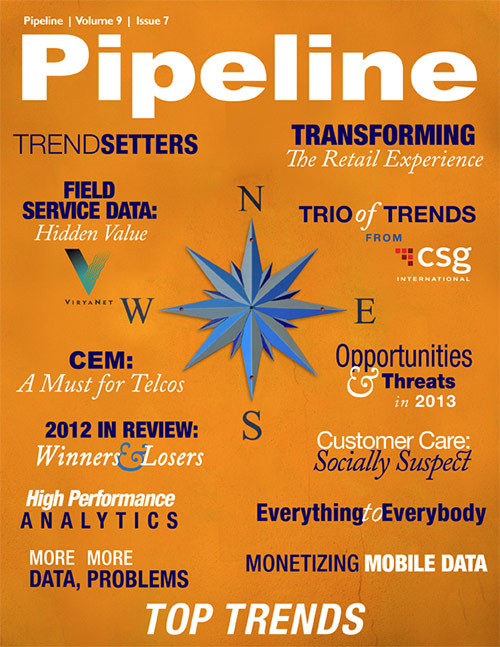Wireless, Broadband, and Wholesale Trends
By: Monica Ricci

CSG International provides software and services to more than 450 telecom service providers and carriers around the world, encompassing every flavor of communications technology and a wide variety of approaches to revenue generation. While each client is unique, there are common threads in the challenges they all face. Here we outline some that are at the top of our minds for 2013.
Wireless providers: data, real time and continued network upgrades
In developed wireless markets in Western Europe and North America, where mobile ubiquity was established years ago, prioritization of data and content services within the communications service provider (CSP) community continues to accelerate as the likeliest source to replace declining voice revenue.
The continued rise of mobile data
Consumers’ use of mobile devices and networks continues to supplant fixed access, particularly among the rising generation of “digital natives.” Multi-device use is a fact of life, as customers increasingly combine handsets, tablets and portable computing devices for both personal and business use, a trend that impacts employers, as we will address later.
As high-capacity networks prevail and 4G tentatively enters most markets around the world, bandwidth-hungry applications of mobile technology are becoming the norm: in particular, video for entertainment, business information and conferencing and cloud-based applications for personal or business productivity are two areas threatening to clog mobile networks while producing little incremental revenue, particularly in emerging markets with little fixed broadband capability. Ericsson and Cisco forecasts indicate that mobile data traffic will increase by a factor of six in the next five years across the globe, driven by increasingly data-capable networks and devices.
Navigating with pricing and policy
For the CSP, the progression of data usage demands a continued focus on pricing plans that are both competitive and aligned with resource usage, facilitating a viable return on costly network investment. But customer retention is also vital in order to maximize the lifetime value of hard-won customers, driving a growing need for accurate segmentation and tailored charging, variable QoS, and engaging with third parties to provide in-demand content and applications. The automated application of business policy to encourage or suppress usage in response to customer behavior will expand the importance of policy control as well as flexible charging to steer and maximize service use.
The past year brought about a wave of mobile pricing approaches that better align price with data consumption while remaining competitive, but they presented themselves in seemingly conflicting ways. In North America players like AT&T and Verizon introduced data caps and price thresholds, while some European operators, such as Three, continued to draw customers with all-you-can-eat data plans. Finally, almost three years after the widespread launch of tablets, we’ve seen the introduction of shared data plans across multiple devices, a sign of recognition from telcos that consumers already own three or more network-connected devices, according to Cisco.





















